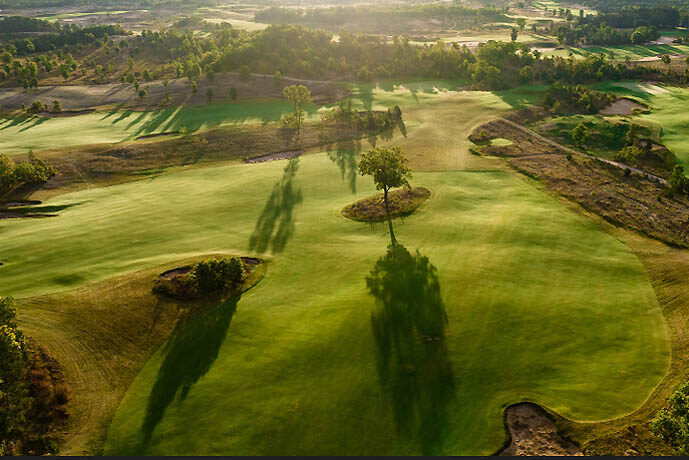3rd 18-hole offering tops out at 5,829 yards
The Keiser family, which developed Bandon Dunes, Sand Valley, Cabot Cape Breton and other top-shelf golf resorts around the globe, has bucked the longer-is-better trend with their new offering, Sedge Valley.
The third 18-hole course at the Sand Valley Resort, a fast-growing destination near Nekoosa, Wisconsin, tops out at 5,829 yards from the back tees and 3,753 yards from the front tees,
Sedge Valley is Tom Doak’s contribution to the central Wisconsin resort, joining Bill Coore and Ben Crenshaw’s Sand Valley course and David MacLay Kidd’s Mammoth Dunes course. The resort also has a 17-hole short course, The Sandbox.
Sedge Valley was inspired by English courses
As Golf Course Architecture magazine writer Richard Humphreys interviewed Doak and wrote:
“I had done routings for three different locations at Sand Valley previously, but never looked at this part of the land,” says Doak. “When Michael Keiser first reached out, he said another architect really liked the land, but he didn’t think there was enough for 18 regulation holes. Michael asked if I would be interested in doing a shorter course – something more like 4,500 or 5,000 yards. I replied that I had always wanted to do something in the 6,000-yard range, like Swinley Forest, Rye and West Sussex, so when I received the maps, that’s what I started to look for.”
Those English layouts provided Doak with inspiration for Sedge Valley, with the architect casting aside any notion of trying to achieve a par of 72 or 7,000-plus yards, and instead routing a course that would mix par threes, short fours and par fours with just a single par five (albeit perhaps the longest in the state).
As the Golf Course Architecture article continued:
“Michael initially thought that the course would start up behind the seventeenth green at Sand Valley, which would be the closest possible spot to the main lodge, so I started trying to route from there,” says Doak. “Later on, he decided to build a separate clubhouse for Sedge, so what I routed as the eighteenth hole is now the first, and my opening hole became the second.”
Humphreys reported that Doak, in an early visit, identified a rocky outcropping on the Keisers’ dunes-covered property “that could become a focal point for the back-to-back par threes.
“My initial routing played up and around the rocks, but wandered onto an outparcel that the resort does not own, so the back-to-back par-three holes I had designed would not work,” Doak told Humprhreys. “In the end I came up with a different set of par threes at the base of the rocks, but the idea of back-to-back threes came from the parcel we couldn’t use!”
Short driveable par 4s to tempt the long hitter
Humphreys wrote:
The opening holes of the final routing give little hint of what’s to come. The start is four consecutive par fours; two relatively gentle holes that provide ample width and might be reached with a drive and a wedge – a warm handshake that is immediately followed by what may become two of the toughest holes of the round – both around the 450-yard mark and the third playing over rolling terrain and featuring a cavernous cluster of bunkers that must be avoided at all costs with the approach.
The course has several short par 4s that will tempt big hitters to try to drive the green. In a nod to its English inspirations, Sedge Valley features “beautiful and individual bunkering that really evokes those classic English heathlands that Doak drew on for inspiration,” Humphreys wrote.
The chief difference between Sedge Valley and the reort’s other 18-hole courses, aside from length, is Doak’s reduced use of sandy waste areas and bunkers around the greens.
As Doak told Humphreys:
“At Sedge, we were trying to do something on a more intimate scale, and there was a lot of native sedge and other plants worth saving. But some of it can present difficulties in finding your ball, so we bunkered the course fairly liberally as a buffer between the target areas and the native plants. Eric Iverson spent a lot of time working on the margins of the course and trying to incorporate the native stuff as much as we could without it becoming too difficult.”
Doak told Humprheys that the lack of length might be off-putting to some U.S. golfers, who generally compete in stroke play, as opposed to their English counterparts who compete in match play.
“We think we’re going to have a course where it’s a real challenge for good players to break par, but where breaking 80 or 90 is a bit easier, because you have more shots in hand. And I’ve always thought that would be the ideal for both groups,” Doak told Humphreys..
“It’s possible some low-handicap golfers will look down on the course because it isn’t longer, and dismiss a good score as misleading, because the course is short. But it’s also possible that a lot of people will enjoy the chance to better their usual score!” he said.
Sedge Valley plays to a par of 68 with five par 3s. A midweek round in mid-September costs $295 for golf only. Single room rates at the Sand Valley Resort range from $325 to $775 a night during peak season. Multi-bedroom cabins and cottages are also available.
This article first appeared in the July 2024 issue of Golf Course Architecture. For a printed subscription or free digital edition, please visit here.
Have a story idea or a news item to report to Alabama Golf News? Email bamagolfnews@gmail.com
Featured image courtesy of the Sand Valley Resort







